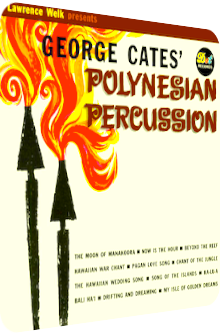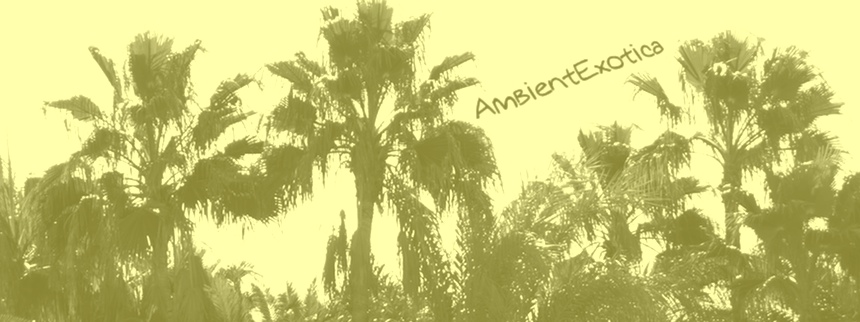
George Cates
Polynesian Percussion
1961
Merging the supposed rhythms of Polynesian islands with warmly glowing Hollywood strings is one of the motifs most often found in the realms of Exotica. Yes, even arranger George Cates (1911–2002) fell in love with the genre, but he substitutes the strings with organs. Polynesian Percussion of 1961 – his one and only dedicated exotic release – finds him and 19 other musicians interpreting 12 classic mellifluous standards. There better be a unique selling point in terms of this album, for in 1961, listeners could already choose between a variety of Exotica releases and related Easy Listening LP's.
Cates gives a glaring hint in the title already, and indeed, almost all of the featured upbeat compositions rely heavily on the clearly audible use of percussion instruments. These are in fact so important to Cates and the marketing people of the Dot label that they list all of them in big letters in the liner notes. The list includes instruments like Guiros, Uli Ulis and Hawaiian Kala'au sticks. I cannot tell them apart or pinpoint them in a specific song, but mind you, their inclusion shows that the record isn't meant as a quick window of opportunity to cash-in, but rather prolifically intertwines the late 50's Exotica concept of featuring the weirdest and rarest instruments with the often times contrasting Easy Listening scheme of delivering hummable, silky skits. Let's see whether Polynesian Percussion is worth it or whether the amount of instruments sounds good on the pixels of your display only.
The LP launches with a surprising Rock rendition of Arthur Freed's and Nacio Herb Brown's Pagan Love Song of 1929. Electric bass guitar slaps by Bill Pitman are the base frame of the whole song. The huge variety of percussive instruments underlines the whirling celeste and the Hawaiian steel guitar sections vividly. The glistening vibes and a sizzling-hot Hammond organ round the jumpy tune off. Charles King's 1926 classic Hawaiian Wedding Song presents the expected saccharine Hawaiian-style steel guitar melodies and flowing vocals by Norma Zimmer, but enhances the whole song with delicious organ backings that outshine the other elements. In this regard, the song succeeds; it fails in terms of the promised Polynesian percussion, for these instruments are hardly heard and consist of standard choices anyway.
Traveling even farther back in time, Prince Leleiohoku's 1860's composition Hawaiian War Chant is next, but Cates' version is conceptually closer to the 1936 rework by Johnny Noble, keeping the quick pace with eclectic percussion sections, a glitzy main melody on the piano that is accompanied by sparkling glockenspiel droplets and splendid percussive soli whose plasticity is a bit disturbed by an overly exuberant melody on an electric piano, but all in all, this is one of the better inclusions on the album.
While Cates' version of Moon Of Manakoora is a successful flute-laden offering with a reduced dreaminess due to the permanently hammering percussion and quick instrumental substitutions, James Lamont Gillespie's 1925 composition Drifting And Dreaming is presented in an undoubtedly interesting flavor with deep trombone backings and cheeky electric guitar notes. However, what works best, I believe, is the distant conga groove whose reverb implies an astonishing wideness and deepness that works well in unison with the coruscating organ cascades. The best track of side A for me, and even the convivial frenzy of the remaining Chant Of The Jungle with its golden streams of polyphonic guitars, soporific ooh-ooh chants and sunny alto flutes can only reach a close second place.
Side B starts with the gorgeous sunset-evoking organ euphony of Bali Ha'i off the musical South Pacific. The laid back mood, the strong Hawaiian flavor, the whirling organ mellowness and the siren-esque chants make this one of the more remarkable Bali Ha'i renditions. Instantly recognizable, I'd say. The traditional Maori song (though you wouldn't guess it due to its title) Now Is The Hour relies a third time on the formula of an electric bass guitar coupling with exotic claves and bongos. The organs and novachords, however, are really shimmering here, making this a strong and less-interpreted goodnight song.
Jack Pitman's Beyond The Reef needs to be included, naturally, and is presented here by a phantasmagoric choir on a rather quick maracas groove, complemented by Hawaiian guitars and Polynesian flute melodies. As I tend to write in every review, nothing beats Arthur Lyman's interpretation, but Cates' try is interesting enough for me to consider listening to it regularly. The following Ka-Lu-A has its strengths as well, mainly because of its tasty concoction of xylophonic and glockenspiel drops, clear-cut percussion and warmly flittering organ goodness.
However, My Isle Of Golden Dreams consists of the same ingredients, but with positively quirky organs of all kinds, making this the slightly stronger realization of the formula. The final Song Of The Island aka Aloha Oe ends the album in a gleaming way with an even stronger focus on the organs, a distant backing choir, tremendously beautiful flute interludes and dreamy mallet instrument curlicues. The world-famous refrain is only played for a short moment, making this a strong closing track that doesn't rely on the fame of the song rather than on the little niches and improvisations that aren't usually linked to its morphogenetic code.
Even though I like quite a few songs of Polynesian Percussion, it doesn't feature too many interesting tidbits, I'm afraid. The inclusion of manifold percussion instruments is as obvious an idea as it is an edge to look forward to. But apart from a few songs where the percussion is either the driving factor as in Chant Of The Jungle or a wideness-enlarging constituent as in Drifting And Dreaming, there is a huge cleft of truly outstanding performances. The album is too whitewashed and bland. Where are the clichéd savagely screams, bird noises, ship horns and the grand scope of things? You won't find these elements in here.
This is a problem, as the album consists solely of renditions and interpretations. Only very few of them remain stuck in my head and let me come back to the album in pleasant anticipation. In fact, if I didn't know any of Cates' arrangements, my life wouldn't be all too worse, I'd still have plenty of Exotica LP's to listen to all year. As is the case with every Exotica release, true collectors own it anyway. But I'm never talking about the collectibility factor alone. It is the aesthetic value – aka the music – that is my main interest, and Cates fails to truly impress me with surprising additions or an outstanding euphony most of the time. The title Polynesian Percussion is brave and bold. The twelve songs don't deliver the promised topos. Since the album is available on iTunes, it's best to cherry-pick your favorites. Drifting And Dreaming and a beautiful alternative take on Song Of The Island are my top picks, with Beyond The Reef and Chant Of The Jungle being my remaining choices.
Exotica Review 078: George Cates – Polynesian Percussion (1961). Originally published on Jun. 9, 2012 at AmbientExotica.com.
